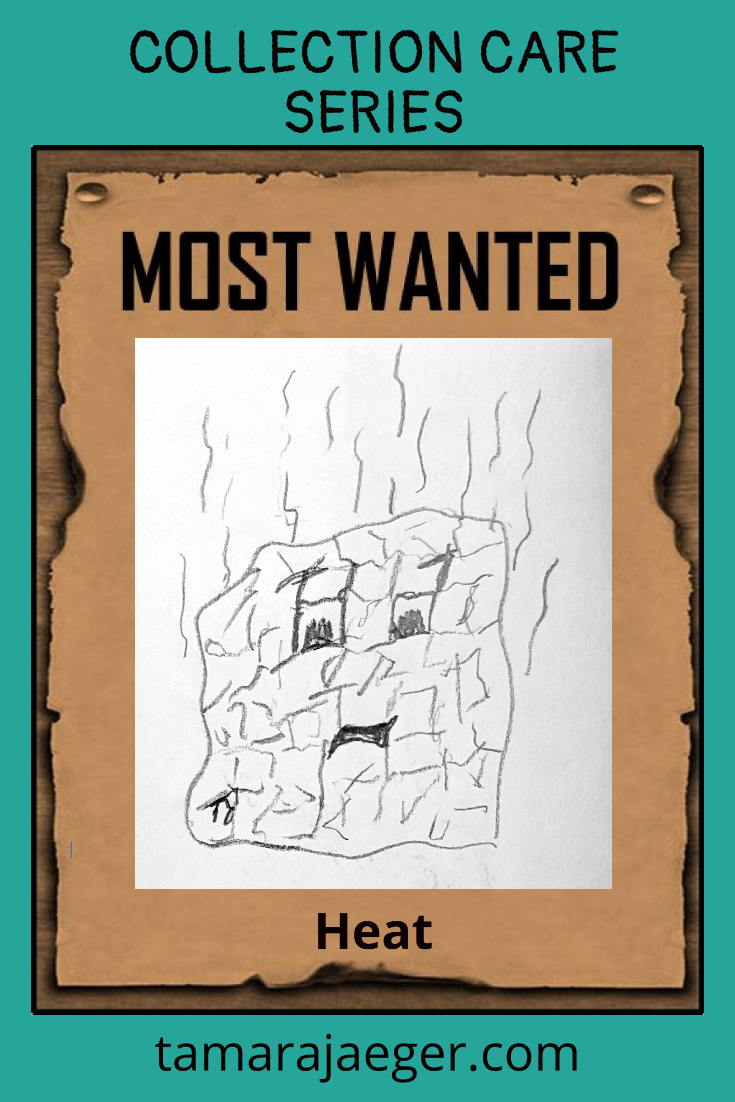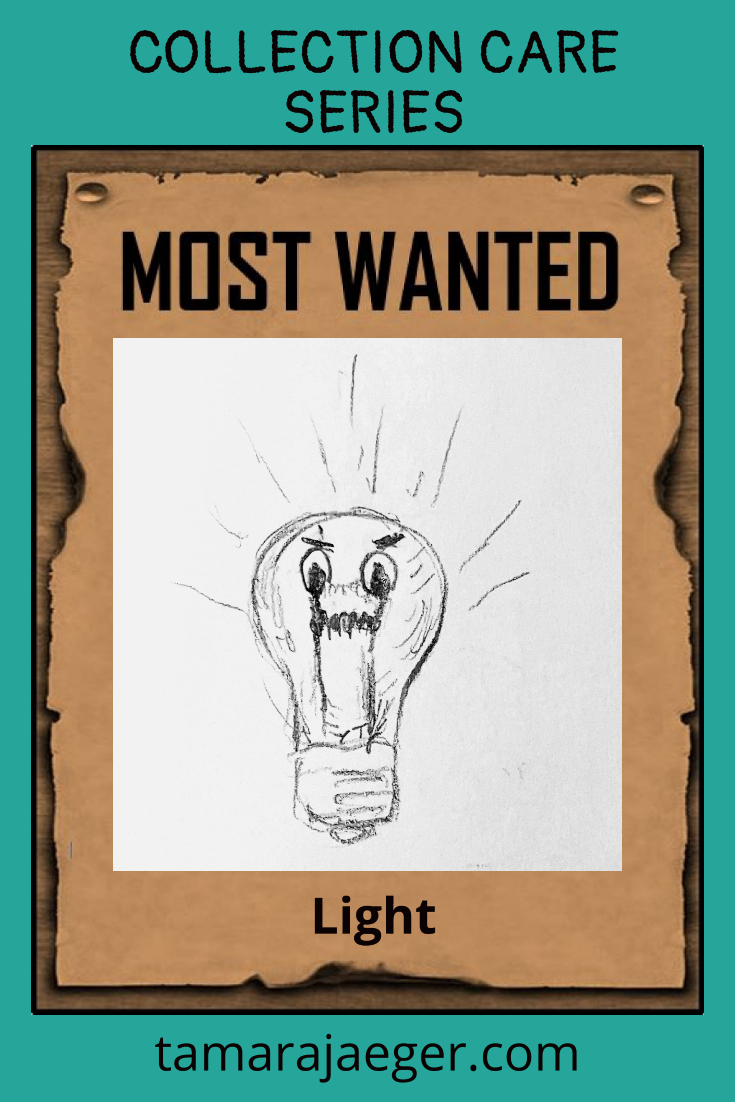Posts Tagged: plastic


Collection Care Series: Enemy #6: The Gang
This week, we’ll be talking about our next enemy, which is really a collection of enemies. I call it: The Gang.
There’s nobody really new here. I just wanted to emphasize that you can get multiple enemies working together, and this type of situation will destroy your treasures even more quickly!
Some dangerous combinations you frequently find are light and heat, humidity/moisture and heat, moisture and insects, and moisture and mold. Or if you’re really unlucky, you can even get moisture, heat, insects, And mold all together! That’s…not a situation you want to find yourself in.

In general terms, for the types of vulnerable materials we’ve been talking about over the last few weeks—like paintings, papers, photos and negatives, wooden items, musical instruments, plastics—you want to avoid bright, direct light, such as sunlight or fluorescent lights. Keep the humidity and temperature moderate—if it’s uncomfortable for you, it’s probably uncomfortable for your treasures.

Avoid really warm areas like attics and garages. Cold is generally okay, but you want to avoid rapid fluctuations in temperature, which can cause rapid humidity fluctuations. Keeping the temperature and humidity stable is also generally more important than maintaining a specific number. Of course, you don’t want the humidity to go over about 70% since that leaves your items susceptible to mold and insect infestations.
For storage, you want to use acid-free, archival materials. Food-grade plastic storage boxes and food storage bags are good choices. Avoid cardboard and newspaper! Don’t store your treasures in areas that aren’t climate controlled—like attics and garages, or in basements where they can get flooded. If you do need to store things in a basement, use plastic storage boxes and try to raise them at least a few inches off the floor.
If you’ve missed any of the previous posts, you can go back and check them out here.
What storage and display concerns have you identified over the last few weeks? Tell me in the comments.
Missed the previous posts? Start at the beginning of the collection care series here.
Want to stay up to date and see more of what I’m working on? Sign up for my mailing list here and get a FREE collection care resource guide. (I promise not to be spammy with my emails—I hate that too!)


Collection Care Series: Enemy #3: Heat
This week, we’ll be talking about our next enemy: Heat.
There are two issues with heat as far as your collections go. First, we have a bit of a chemistry-based issue. Higher temperatures increase chemical reaction rates and many deterioration processes are due to chemical reactions. So storing your item somewhere hot will cause it to deteriorate faster, even in the absence of other risk factors, such as light, which we talked about here. Secondly, higher temperatures usually result in lower relative humidity levels. If you missed it, we discussed problems related to humidity here.

Some items that can be damaged by heat include plastics, photos and negatives, paintings, and musical instruments. For these materials, avoid rapid changes in temperature, which can cause rapid humidity fluctuations. Plastics and photographic negatives are particularly susceptible to chemical degradation, which is accelerated at high temperatures. Avoid storing them in areas that can get very warm, such as attics or garages. You also want to keep in mind that when very cold, plastics get brittle and are vulnerable to damage from dropping or crushing. Again, don’t store them in places like attics and garages, since these areas tend to experience extremes and rapid changes in temperature and humidity levels.
Where do you store your vulnerable treasures? Tell me in the comments.
Check out the next post in the collection care series here.
Missed the previous posts? Start at the beginning of the collection care series here.
Want to stay up to date and see more of what I’m working on? Sign up for my mailing list here and get a FREE collection care resource guide. (I promise not to be spammy with my emails—I hate that too!)


Collection Care Series: Enemy #1: Light
Fun fact: I actually trained and worked as a museum conservator for a number of years. I specialized in archaeological and ethnographic materials, but also covered the basics of conservation of most traditional fine art and decorative art materials—you never know what you’re going to encounter, particularly with ethnographic objects!
Everyone has their ‘treasures’ that they want to preserve for as long as possible, right? Maybe it’s a crayon drawing from your first child. Maybe it’s something you inherited from your grandparents. Or maybe it’s a piece of art you got at a fair and just really enjoy. Whatever it is, you want it to last, so I thought it might be helpful to go over basic care information for some of the more common materials found in peoples’ houses. We’ll do this as a multi-part series, where I’ll focus on a different collection risk factor each week and which materials are most at risk. As a bonus, I put together a short guide covering some common items with simple recommendations for storage or display as well as a list of resources where you can get more information or professional conservation services. You can get it here.
Enemy #1: Light
This week, we’ll be talking about the first ‘enemy,’ Light.

Light can cause a lot of damage, particularly UV light. I’m not going to go into the chemistry involved in light damage (I mean, I totally could, but I don’t want to bore everyone to tears!), so just keep in mind that sunlight and fluorescent lights can be particularly damaging.
Some common items that can be damaged by light include paintings, paper, photos and negatives, and plastics. Plastics are actually becoming increasingly common in museum collections and despite all the press about them never breaking down, plastics can degrade quite badly and pose a lot of problems for preservation. So, you know those plastic dinosaurs or toy horses you had as a kid that you want to hang on to? They need a little TLC to keep them in good shape.
On of the main signs of light damage is fading and discoloration. Along with discoloration, many materials will also become quite brittle. Both are signs of the underlying chemical deterioration that is taking place. Places you’ll see light damage are with paintings, particularly things like watercolors, and prints on paper, as well as photos and negatives. You may notice that artwork that was displayed near a window has faded or discolored. Also, some colors are affected more than others, so the overall color of the print will have shifted. Reds and blues are often the first victims of light damage. Plastics will discolor and, if originally colored, will fade as well, often getting a hazy, whitish film on the surface. You see this sometimes on older plastic playground equipment, since it’s exposed to the sunlight all the time.
Now, unfortunately, light damage is cumulative and permanent. If you have something that’s faded or discolored from light, there’s no fixing it. But you can help prevent further damage by limiting the amount of light it’s exposed to in the future. If your treasure hasn’t been damaged by light yet, fantastic! Let’s keep it that way so you can enjoy it for years to come.
As far as preventing light damage, it’s really quite simple: don’t expose your item to a lot of light. I don’t mean you have to keep everything in complete darkness all the time (though that’s the best way to prevent light damage). After all, you still want to enjoy your treasures, otherwise what’s the point? Just keep them away from bright light. Don’t hang them near windows or under fluorescent lights. If you have something like a really old photo you want to display but don’t want to damage (or damage further), consider getting it reprinted on modern photo paper and displaying that. You can then keep the original stored away from light entirely to preserve it as long as possible.
There’s a peculiarity you should know about with oil paintings, however. You should avoid storing oil paintings in complete darkness as this will cause the linseed oil in the paint to darken or yellow. This color change is different from the light damage we’ve been talking about, however, and actually can be reversed by placing the painting in natural light for a few days.
Do you have any treasures that you think are vulnerable to light damage? Let me know in the comments!
Check out the next post in the collection care series here.
Want to stay up to date and see more of what I’m working on? Sign up for my mailing list here and get a FREE collection care resource guide. (I promise not to be spammy with my emails—I hate that too!)